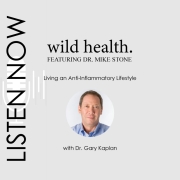If you want to eat for long-term health, lowering inflammation is crucial.
Inflammation in the body causes or contributes to many debilitating, chronic illnesses – including osteoarthritis, rheumatoid arthritis, heart disease, Alzheimer’s disease, Parkinson’s disease, and even cancer. That’s why, as a doctor and founder of the Kaplan Center for Integrative Medicine, I recommend my patients eat a diet focused on anti-inflammatory principles.
Recent research finds that eating this way not only helps protect against certain diseases, but it also slows the aging process by stabilizing blood sugar and increasing metabolism. Plus, although the goal is to optimize health, many people find they also lose weight by following an anti-inflammatory eating pattern.
Here, I’m sharing the 11 principles I recommend everyone incorporate into their diet for optimal health:
1. Consume at least 25 grams of fiber every day.
A fiber-rich diet helps reduce inflammation by supplying naturally occurring anti-inflammatory phytonutrients found in fruits, vegetables, and other whole foods.
To get your fill of fiber, seek out whole grains, fruits, and vegetables. The best sources include whole grains such as barley and oatmeal; vegetables like okra, eggplant, and onions; and a variety of fruits like bananas (3 grams of fiber per banana) and blueberries (3.5 grams of fiber per cup).
2. Eat a minimum of nine servings of fruits and vegetables every day.
One “serving” is half a cup of a cooked fruit or vegetable or one cup of a raw leafy vegetable.
For an extra punch, add anti-inflammatory herbs and spices such as turmeric and ginger to your cooked fruits and vegetables to increase their antioxidant capacity.
3. Eat four servings of both alliums and crucifers every week.
Alliums include garlic, scallions, onions, and leeks, while crucifers refer to vegetables such as broccoli, cabbage, cauliflower, mustard greens, and Brussels sprouts.
Because of their powerful antioxidant properties, consuming a weekly average of four servings of each can help lower your risk of cancer.
If you like the taste, I recommend eating a clove of garlic a day!
4. Limit saturated fat to 10 percent of your daily calories.
By keeping saturated fat low (that’s about 20 grams per 2,000 calories), you’ll help reduce the risk of heart disease.
You should also limit red meat to once per week and marinate it with herbs, spices, and tart, unsweetened fruit juices to reduce the toxic compounds formed during cooking.
5. Consume foods rich in omega-3 fatty acids.
Research shows that omega-3 fatty acids reduce inflammation and may help lower the risk of chronic diseases and conditions that have a high inflammatory process at their root.
Aim to eat lots of foods high in omega-3 fatty acids like flax meal, walnuts, and beans such as navy, kidney, and soy. I also recommend taking a good-quality omega-3 supplement.
And of course, consume cold-water fish such as salmon, oysters, herring, mackerel, trout, sardines, and anchovies. Speaking of which:
6. Eat fish at least three times a week.
Choose both low-fat fish such as sole and flounder and cold-water fish that contain healthy fats, like the ones mentioned above.
7. Use oils that contain healthy fats.
The body requires fat but choose the fats that provide you with benefits.
Virgin and extra-virgin olive oil and expeller-pressed canola are the best bets for anti-inflammatory benefits. Other options include high-oleic, expeller-pressed versions of sunflower and safflower oil.
8. Eat healthy snacks twice a day.
If you’re a snacker, aim for fruit, plain or unsweetened Greek-style yogurt (it contains more protein per serving), celery sticks, carrots, or nuts like pistachios, almonds, and walnuts.
9. Avoid processed foods and refined sugars.
This includes any food that contains high-fructose corn syrup or is high in sodium, both of which contribute to inflammation throughout the body.
Avoid refined sugars whenever possible and artificial sweeteners altogether. The dangers of excess fructose have been widely cited and include increased insulin resistance (which can lead to type-2 diabetes), raised uric acid levels, raised blood pressure, increased risk of fatty liver disease, and more.
10. Cut out trans fats.
In 2006, the FDA required food manufacturers to identify trans fats on nutrition labels, and for good reason – studies show that people who eat foods high in trans fats have higher levels of C-reactive protein, a biomarker for inflammation in the body.
A good rule of thumb is to always read labels and steer clear of products that contain the words “hydrogenated” or “partially hydrogenated oils.” Vegetable shortenings, select kinds of margarine, crackers, and cookies are just a few examples of foods that might contain trans fats.
11. Sweeten meals with phytonutrient-rich fruits and flavor foods with spices.
Most fruits and vegetables are loaded with important phytonutrients. In order to naturally sweeten your meals, try adding apples, apricots, berries, and even carrots.
And for flavoring savory meals, go for spices that are known for their anti-inflammatory properties, including cloves, cinnamon, turmeric, rosemary, ginger, sage, and thyme.
Bon appétit!
First published on October 30, 2015; updated February 10, 2023.
We are here for you, and we want to help.
Our goal is to return you to optimal health as soon as possible. To schedule an appointment please call: 703-532-4892 x2





